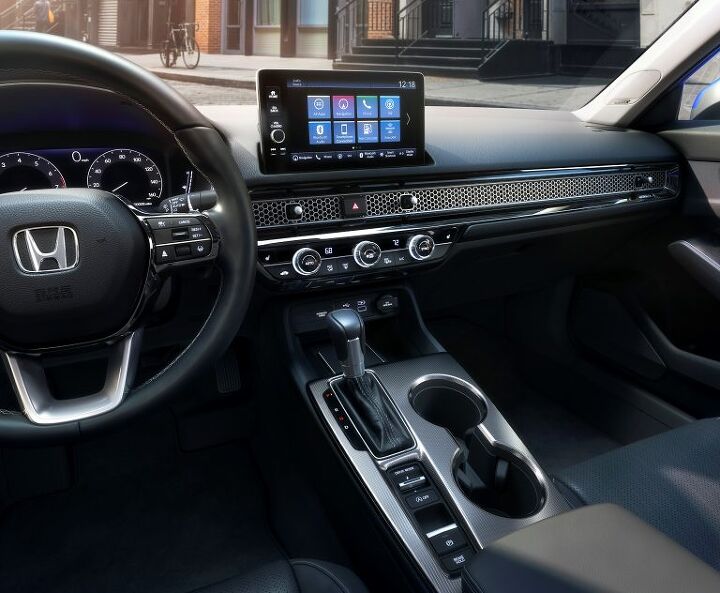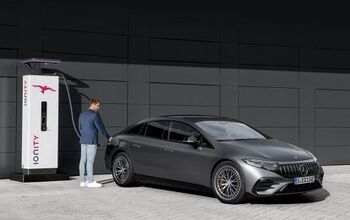2022 Honda Civic Sedan Restores Dignity With New Exterior, Plenty of Updates

The 2022 Honda Civic sedan has finally arrived, donned in conservative body panels that make the automobile come across as more attractive and adult than its predecessor. While the tenth-generation model had a lot going for it, its appearance was quite polarizing. Honda designers created an angular buffet that made every Civic look as though it had been customized inside a videogame where caricatures of gearheads argue with each other about who will become the local street racing champ.
It was perhaps too exciting for a vehicle that’s primarily designed for mundane tasks, which is why Honda ran in the complete opposite direction with the eleventh generation. Reminiscent of the straightforward fifth-generation model, the newest Civic boasts the cleanest bodywork we’ve seen in decades and will provide a significant amount of wiggle room for designers to better differentiate performance variants.
The interior has followed suit. Honda is promising better materials but the design itself is the real achievement, reaching this nice equilibrium between contemporary and classic. Ergonomics also seem solid, with the manufacturer opting against putting every single control on the 7.0-inch touchscreen that juts out of the dashboard. HVAC knobs remain in play and the same goes for volume and tuning, proving Honda has learned its lesson. Apple CarPlay and Android Auto are standard, though customers can option higher trimmed sedans to get access to the 9.0-inch touchscreen (and larger instrument cluster) offering complete wireless mirroring.
While we shrug off most advanced driving systems as gimmicky trash that’s just making everyone a crappier driver, manufacturers have been marketing these features like crazy and consumers are beginning to take an interest in them. Just know that the 2022 Honda Civic is offering everything its rivals have and we’ll need to test it ourselves to see if its suite of digital nannies are better than what’s on the Toyota Corolla.
However, the powertrain options are a sure thing since the Civic sedan is carrying over the tenth generation’s motors. A naturally aspirated 2.0-liter inline-four will be the standard mill inside LX and Sport models, while EX and Touring trims will get the more exciting 1.5-liter turbo. Sadly, these all come with continuously variable transmissions (CVTs) that make us slightly concerned.
Despite being exceptionally efficient for drivers and cost-effective for manufacturers, CVTs have a bad habit of sucking all the personality from a vehicle — regardless of who manufactured it. But they’ve gotten better over time and Honda has promised that its system has been modified to enhance responsiveness. It has also been made more robust, thanks to the inclusion of an upgraded electric hydraulic pump and secondary shaft using ball bearings.
Those that still find that unacceptable will be pleased to know that Honda plans on offering manual transmissions on both the Civic Si and Type R. Performance units will also boast substantially higher outputs than the standard powerplants, too. But they’ve also seen a few enhancements. The 2.0-liter motor (158 horsepower and 138 pound-feet of torque) comes with a new stop-start system to help save on fuel while the 1.5-liter turbo (180 hp and 177 pound-feet) sees a slight bump in performance vs its predecessor.
Fuel economy is similarly refined. Honda is estimating 31 city/40 highway for LX models, 30/37 for the Sport, 33/42 with the EX, and 31/38 on the Touring trim. Weight also isn’t half bad with all sedans coming in between 2,877 and 3,077 pounds.
Eleventh-gen Civics receive frontal MacPherson struts boasting low-friction ball joints and front damper mount bearings. The sedan’s wheelbase has also been stretched 1.5 inches with the track getting a half-inch wider. According to the manufacturer, this comes with “an 8 percent improvement in torsional rigidity and 13-percent improvement in bending rigidity versus the previous generation.”
This bundle of little changes will hopefully make the 2022 Honda Civic more appealing to consumers. With sales declining since 2018, the model has lost some of its relevance — which we can probably blame on the sudden popularity of crossover vehicles. Still, the prior generation took some risks that didn’t pay off and the new Accord Jr. look definitely addresses them. Maybe we’ll even start seeing Civic sales back on the rise.
The hatchback faithful will need to keep waiting. But those interested in a Civic sedan should be able to find one over the summer. Pricing should start somewhere around $23,000, though we’ll have to wait on Honda to provide official confirmation.
[Images: Honda]

A staunch consumer advocate tracking industry trends and regulation. Before joining TTAC, Matt spent a decade working for marketing and research firms based in NYC. Clients included several of the world’s largest automakers, global tire brands, and aftermarket part suppliers. Dissatisfied with the corporate world and resentful of having to wear suits everyday, he pivoted to writing about cars. Since then, that man has become an ardent supporter of the right-to-repair movement, been interviewed on the auto industry by national radio broadcasts, driven more rental cars than anyone ever should, participated in amateur rallying events, and received the requisite minimum training as sanctioned by the SCCA. Handy with a wrench, Matt grew up surrounded by Detroit auto workers and managed to get a pizza delivery job before he was legally eligible. He later found himself driving box trucks through Manhattan, guaranteeing future sympathy for actual truckers. He continues to conduct research pertaining to the automotive sector as an independent contractor and has since moved back to his native Michigan, closer to where the cars are born. A contrarian, Matt claims to prefer understeer — stating that front and all-wheel drive vehicles cater best to his driving style.
More by Matt Posky
Latest Car Reviews
Read moreLatest Product Reviews
Read moreRecent Comments
- Kjhkjlhkjhkljh kljhjkhjklhkjh A prelude is a bad idea. There is already Acura with all the weird sport trims. This will not make back it's R&D money.
- Analoggrotto I don't see a red car here, how blazing stupid are you people?
- Redapple2 Love the wheels
- Redapple2 Good luck to them. They used to make great cars. 510. 240Z, Sentra SE-R. Maxima. Frontier.
- Joe65688619 Under Ghosn they went through the same short-term bottom-line thinking that GM did in the 80s/90s, and they have not recovered say, to their heyday in the 50s and 60s in terms of market share and innovation. Poor design decisions (a CVT in their front-wheel drive "4-Door Sports Car", model overlap in a poorly performing segment (they never needed the Altima AND the Maxima...what they needed was one vehicle with different drivetrain, including hybrid, to compete with the Accord/Camry, and decontenting their vehicles: My 2012 QX56 (I know, not a Nissan, but the same holds for the Armada) had power rear windows in the cargo area that could vent, a glass hatch on the back door that could be opened separate from the whole liftgate (in such a tall vehicle, kinda essential if you have it in a garage and want to load the trunk without having to open the garage door to make room for the lift gate), a nice driver's side folding armrest, and a few other quality-of-life details absent from my 2018 QX80. In a competitive market this attention to detai is can be the differentiator that sell cars. Now they are caught in the middle of the market, competing more with Hyundai and Kia and selling discounted vehicles near the same price points, but losing money on them. They invested also invested a lot in niche platforms. The Leaf was one of the first full EVs, but never really evolved. They misjudged the market - luxury EVs are selling, small budget models not so much. Variable compression engines offering little in terms of real-world power or tech, let a lot of complexity that is leading to higher failure rates. Aside from the Z and GT-R (low volume models), not much forced induction (whether your a fan or not, look at what Honda did with the CR-V and Acura RDX - same chassis, slap a turbo on it, make it nicer inside, and now you can sell it as a semi-premium brand with higher markup). That said, I do believe they retain the technical and engineering capability to do far better. About time management realized they need to make smarter investments and understand their markets better.








































Comments
Join the conversation
To me that dash looks so much like certain dashes from the 60's that I almost expect it to be made out of painted stamped steel. I guess they are aiming at a younger crowd that wouldn't remember cars that old.
Can we please stop with the tacked-on iPad-on-the-dash look?